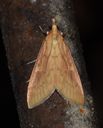Hodges#4946
Ostrinia penitalis
Classification
- Phylum: Arthropoda
- Subphylum: Hexapoda
- Class: Insecta
- Order: Lepidoptera
- Superfamily: Pyraloidea
- Family: Crambidae
- Subfamily: Pyraustinae
- Tribe: Pyraustini
- Genus: Ostrinia
- Species: penitalis
Pronunciation
How to pronounce Ostrinia penitalis: /ɒsˈtriːniə pɛnɪˈtɑːlɪs/
These audio files are automatically generated. While they are not always 100% accurate, they are a good starting point.
Images






Summary
Ostrinia penitalis, also known as the American lotus borer, is a species of moth in the family Crambidae. It was first described by Augustus Radcliffe Grote in 1876. This moth is known for its distinctive wing patterns and is primarily found in marshy areas across North America and Central America.
Physical Characteristics
Wingspan of about 21 mm; adult forewing orangish to light brown with zigzag AM line and jagged PM line; hindwing light gray with yellowish shading in outer half.
Identification Tips
Look for the large projecting 'tooth' near the inner margin of the PM line on the forewing, and the dark diffuse blotch on the outer part of the median area.
Habitat
Marshes and pondsides.
Distribution
Found from Quebec to British Columbia and throughout the United States, south to the Amazon basin.
Diet
Larvae feed on American lotus (Nelumbo lutea) and various species of Smartweed (Polygonum).
Life Cycle
Eggs are laid on the upper surface of hostplant leaves; young larvae attach themselves to the leaf by silken strands; mature larvae may form silk nets and tunnel into the leaf petiole for pupation.
Reproduction
A mass of up to 60 eggs can be laid on a hostplant, covered with an amber-colored substance.
Ecosystem Role
Herbivore; larvae feed on aquatic plants.
Tags
- moth
- lepidoptera
- Crambidae
- Ostrinia